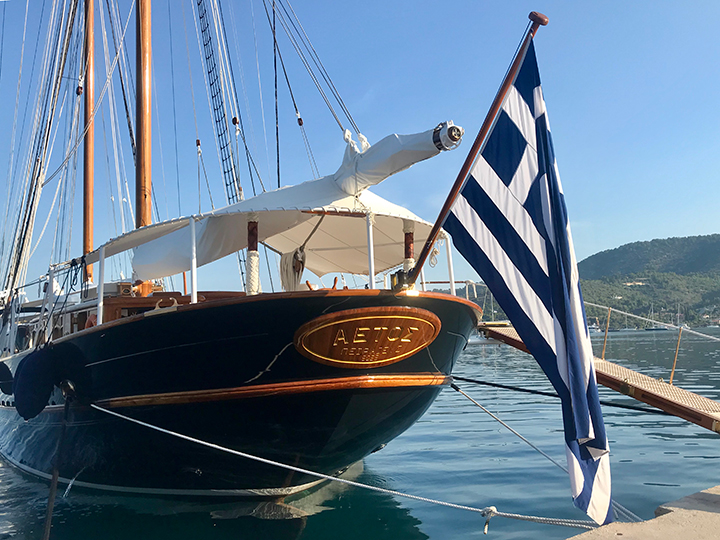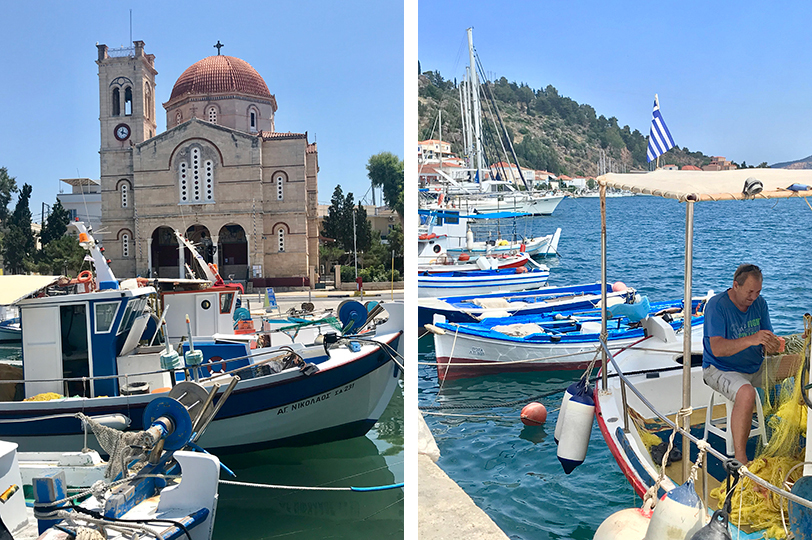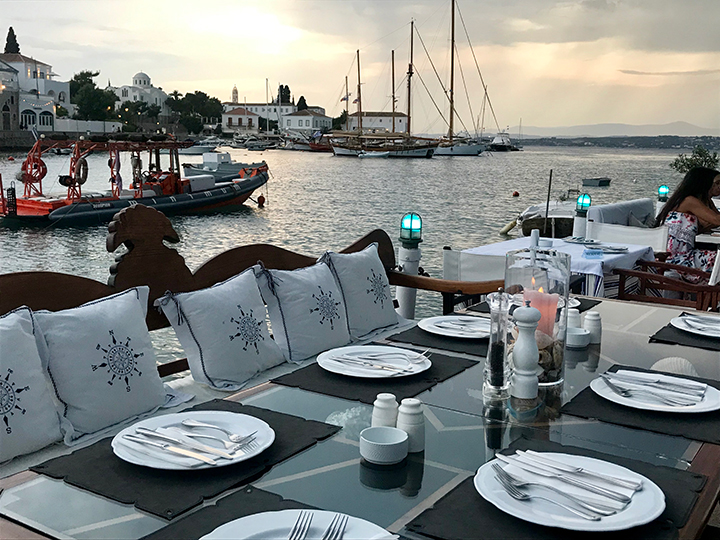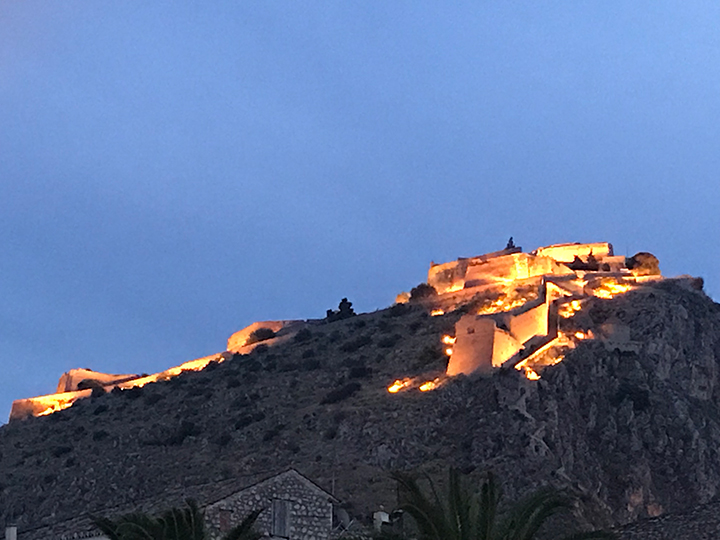Spetses & Navplion
Off the beaten path for many Greek charters but worth every minute
Text & images by | ZUZANA PROCHAZKA










Greece is one of those charter destinations that begs for repeat visits. Having cruised there three times already, I can’t wait to return because on each charter, I find something new and gorgeous. My last trip with Navigare Yachting was no exception.
We chartered from Agios Kosmas Marina just down a way from the port of Piraeus outside of Athens. Our Navigare Sun Odyssey 519, Misty, was ready and waiting at the dock, completely spotless. Our welcome at the base was enthusiastic as we had three fun and knowledgeable locals at our disposal.
We loaded only barebones provisions, which in Greece always consist of olives, tomatoes, pounds of feta and multiple bottles of local wine. There’s no need to overbuy on a Greek charter because the provisioning opportunities are many and the tavernas beckon like sirens from the shore.
I love recommendations by locals since they never disappoint and our base guys were eager to share insights. With their guidance, I pointed Misty’s bow toward Spetses Island to the southwest and then to Navplion (also spelled Nafplio and Nauplion) at the top of the Argolic Gulf.
Spetses Island
The first day was long. We sailed nearly 50 miles on a nice beam reach through Kolpos Idras or Hydra Gulf. We pulled into the miniscule harbor of Spetses Island at dusk with a storm behind us. The harbor is a mix of private yachts, commercial boats and fishing craft and it shoals to four feet the farther back you go. I read the guides but remained nervous as we glided in. Finally, not having the stomach to run aground, I did a U-turn and headed back out to the bay to drop anchor with the other cruisers. We made it just before the storm rolled through.
Ashore, we heard the hooves of horses pulling carriages from one end of town to the other. We dinghied to a stone quay and followed directions to Liotrivi, a seafood restaurant that was recommended by the base. I had no idea that Spetses is a gastronomic hub with dozens of specialty eateries bunched together in a tiny town. Liotrivi is spectacular with an unmatched waterside setting and old school impeccable service. That said, every café and restaurant we passed was postcard-worthy – with candlelit charm and mouthwatering aromas on the breeze. No wonder the beautiful people of Athens hop on their yachts or the ferry to come weekend here.
In the morning, we explored the other side of town but instead of taking a carriage, we walked along the quay where fishermen mended their nets. We headed to the house of local heroine, Laskarina Bouboulina, a commander in the War of Greek Independence of 1821. Bouboulina was born in a Constantinople prison but rose to the rank of admiral and the museum is housed in the 300-year-old mansion that served as her home on Spetses. Bouboulina died in a family duel four years after her command. What a colorful personality right through to her demise.
After learning more about the woman who was fast becoming my muse and a nutritious lunch of ice cream, we head back to the boat, raised anchor and set our course north, up the Argolic directly into a light breeze.
Navplion
It was a long motor in a light breeze to Navplion but soon enough we Med moored on the quay below the imposing fortress of Palamidi, which hangs over the town below. This behemoth was built by the Venetians during their occupation of the Peloponnese Peninsula in the early 1700s. It’s commanding and mesmerizing at the same time. Up for a bit of exercise, we braved the thousand steps it takes to reach it. (A bus runs up as well for those who are less foolish.) That night we strolled through the town’s maze of galleries and shops, listened to street musicians and had a delicious fish dinner.
The following day we rented a car and drove north. Greece is wonderful but can be challenging, especially by car. There are multiple ways to spell every Greek town or island name. Just to make it more confusing, the old town on every island is called Hora or Chora and street names are written in the Greek alphabet so navigation on water is actually easier than on land.
With only a few wrong turns, we arrived at the archaeological sites of Mycenae and Tiryns. These ruins from the 15th to the 12th century BC were two cities at the heart of Mycenaen society, which is linked to Homer’s Iliad and Odyssey. What has been preserved and/or rebuilt onsite is exceptional. If you can get away from the busloads of tourists, which pulse through the place from mid-morning to mid-afternoon, you may just settle into a feeling of awe, contemplating the civilization that ruled here so many years ago.
It was blazing on the barren hill so once we descended, we set sights on Epidavros (also Epidaurus) only about 40 miles to the east, tucked into a scrappy pine forest. The asclepeion at Epidavros was a celebrated healing center for wealthy patrons. The actual medicine of the time was a mix of mineral spring baths, exercise and a dose of Greek mythology. People came from miles around in hopes of being cured of whatever ailed them. To find out the nature of their illness, they spent the night in the enkoimeteria, the sleeping hall. In their dreams, the god Asclepius would advise on their course of treatment. The focus of the whole complex was on physical exercise in the stadium and relaxation in the well-preserved amphitheater used for dramatic performances. The stone theater is world renowned for its design and famous for its perfect acoustics. It can seat 14,000 spectators and is still used for performances today.
It’s funny how advanced the Greeks were. Already back then, they knew that good health requires minimal stress and a revitalized spirit. I grew envious of all who partook of this ancient spa.
Heading Home
It was time to return so I set course toward Athens via Ermioni, a small seaside town on the Peloponnese mainland. This adorable village sits on a natural outcropping with water on three sides so it feels like an island. Its natural horseshoe-shaped bay has a tiny inner harbor protected by a jetty but a more popular place to tie up is on the western side where waterfront taverans abound.
Like all villages in Greece, Ermioni just begs to have its picture taken and you can’t really go wrong no matter where you point the lens. We walked from one side of town to the other via the pinewood park, led by our very own canine escort who took it upon himself to guide tourists around his home town. That night, it was wine on the quay and sunset over the water.
The next morning we hiked the narrow streets up over the crown of the town and descended to the other side to visit Drougas bakery that serves fresh squeezed orange juice, coffee and every kind of Greek baked good under the sun. We lucked out and stumbled upon Ermioni’s weekly farmer’s market. From ladies’ lingerie to live chickens, it seems you can get it all in Ermioni on a Thursday morning. We loaded up on fruit and headed for home.
Navplion is seldom visited by charterers but it’s a must see and a great launch site to some of the most important Peloponnese archeological sites. Spetses is just a gem and the anchorage outside is large and comfortable in the right weather. Ermioni is popular with charter boats but since many are on a set itinerary, tying up there on a Thursday leaves mostly locals to talk to. Bliss.
Heading farther from the maddening crowd takes a bit of deck time but in the case of Spetses and Navplion, it’s absolutely worth ever minute of getting there.